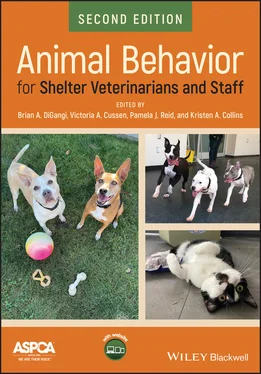Animal Behavior for Shelter Veterinarians and Staff
Здесь есть возможность читать онлайн «Animal Behavior for Shelter Veterinarians and Staff» — ознакомительный отрывок электронной книги совершенно бесплатно, а после прочтения отрывка купить полную версию. В некоторых случаях можно слушать аудио, скачать через торрент в формате fb2 и присутствует краткое содержание. Жанр: unrecognised, на английском языке. Описание произведения, (предисловие) а так же отзывы посетителей доступны на портале библиотеки ЛибКат.
- Название:Animal Behavior for Shelter Veterinarians and Staff
- Автор:
- Жанр:
- Год:неизвестен
- ISBN:нет данных
- Рейтинг книги:5 / 5. Голосов: 1
-
Избранное:Добавить в избранное
- Отзывы:
-
Ваша оценка:
- 100
- 1
- 2
- 3
- 4
- 5
Animal Behavior for Shelter Veterinarians and Staff: краткое содержание, описание и аннотация
Предлагаем к чтению аннотацию, описание, краткое содержание или предисловие (зависит от того, что написал сам автор книги «Animal Behavior for Shelter Veterinarians and Staff»). Если вы не нашли необходимую информацию о книге — напишите в комментариях, мы постараемся отыскать её.
A comprehensive resource to understand the behavioral considerations for intake, management, and rehoming of dogs and cats Animal Behavior for Shelter Veterinarians and Staff
Animal Behavior for Shelter Veterinarians and Staff — читать онлайн ознакомительный отрывок
Ниже представлен текст книги, разбитый по страницам. Система сохранения места последней прочитанной страницы, позволяет с удобством читать онлайн бесплатно книгу «Animal Behavior for Shelter Veterinarians and Staff», без необходимости каждый раз заново искать на чём Вы остановились. Поставьте закладку, и сможете в любой момент перейти на страницу, на которой закончили чтение.
Интервал:
Закладка:
Table of Contents
1 Cover
2 Title Page Animal Behavior for Shelter Veterinarians and Staff Edited by Brian A. DiGangi, DVM, MS, DABVP Senior Director, Shelter Medicine Shelter & Veterinary Services ASPCA® Gainesville, FL, USA Victoria A. Cussen, PhD, CAAB Senior Director, Applied Behavior Research Behavioral Sciences Team ASPCA® Seattle, WA, USA Pamela J. Reid, PhD, CAAB Vice President Behavioral Sciences Team ASPCA® Hendersonville, NC, USA Kristen A. Collins, MS, ACAAB Vice President, Behavioral Rehabilitation Services ASPCA® Mars Hill, NC, USA Second Edition
3 Copyright Page
4 List of Contributors
5 Foreword
6 Acknowledgments
7 About the Companion Website
8 Part I: Foundations in Behavioral Health Introduction 1 Introduction to Dog Behavior 1.1 Evolutionary History of the Species 1.2 Dogs and Humans 1.3 Dog Behavioral Development 1.4 Dog Communication 1.5 Complex Behaviors 1.6 Influences on Dog Behavior 1.7 Conclusions Acknowledgments References 2 Introduction to Cat Behavior 2.1 Introduction 2.2 Domestication 2.3 Sensory Perception 2.4 Communication 2.5 Behavioral Development 2.6 Maintenance Behaviors 2.7 Sociality 2.8 Learning and Cognition 2.9 Conclusions References 3 How Animals Learn 3.1 Introduction: What Is Learning? 3.2 Non‐associative Learning 3.3 Associative Learning 3.4 Effectiveness of Consequences 3.5 Conclusions References 4 The Relationship between Physiology and Behavior in Dogs and Cats 4.1 Introduction 4.2 General Concepts of the Relationship between Medical and Behavioral Issues 4.3 Recognizing the Behavior of the Sick Animal 4.4 The Role of Stress 4.5 The Behavior of Pain 4.6 Common Medical Conditions Resulting in Behavioral Signs 4.7 Medical Conditions That Have Breed Tendencies and Their Associated Behavior Changes 4.8 Behavior and/or Medical Conditions Seen in Intact versus Neutered Dogs 4.9 Behavior and/or Medical Conditions Seen in Intact versus Neutered Cats 4.10 Side Effects of Common Medications 4.11 Conclusions References
9 Part II: Pets in the Community 5 Safety Net Programs 5.1 Introduction 5.2 Benefits of Safety Net Programs 5.3 Program Types 5.4 How to Choose the Right Programs 5.5 Conclusions References 6 Dog Behavior and Relinquishment to Shelters 6.1 Introduction 6.2 A Brief History of Relinquishment Data 6.3 Lessons Learned from Risk Factor Studies 6.4 The Importance of Definitions 6.5 The Challenge of Determining How and When Behaviors May Threaten Human‐Canine Bonds 6.6 Preventing Behavior‐Related Relinquishment and Facilitating Adoptions: Compatible or Competing Priorities? 6.7 How Have Relinquishment Prevention Measures Worked? 6.8 Behavioral Interventions That May Promote Adoptions and Prevent Returns 6.9 Conclusions References 7 Management of Community Cats 7.1 Introduction 7.2 Effective TNR 7.3 Return to Field 7.4 Continuing Controversies around TNR 7.5 Communication 7.6 Cat Impact in the Community 7.7 Cat Behavior in the Community 7.8 Keeping Community Cats Out of the Shelter 7.9 Community Cats in the Shelter 7.10 Conclusions References
10 Part III: Dogs in the Shelter 8 Handling Shelter Dogs 8.1 Introduction 8.2 What Is Stress? 8.3 Stress in Shelter Dogs 8.4 Body Language 8.5 Responding to the Dog’s Emotional State 8.6 Low‐Stress Handling 8.7 Defensive Handling 8.8 Handling Dogs during the Process of Euthanasia 8.9 Conclusions References 9 Assessing the Behavior of Shelter Dogs 9.1 Introduction 9.2 Sources of Behavior Information 9.3 Behavior Information and Pathway Planning 9.4 Conclusions Acknowledgments References 10 Canine Housing and Husbandry for Behavioral Well‐Being 10.1 Introduction 10.2 Admission to the Animal Shelter 10.3 General Housing Considerations 10.4 Behavior and Sensory Factors to Consider for Dog Housing 10.5 Types of Primary Enclosures 10.6 Co‐housing in Pairs or Small Groups 10.7 Areas for Enrichment, Exercise, and Training 10.8 Initial Housing Considerations 10.9 Housing during Disasters 10.10 Conclusions References 11 Canine Enrichment 11.1 Introduction 11.2 Enrichment Interventions in the Animal Shelter 11.3 Assessing Enrichment 11.4 Implementing and Maintaining an Enrichment Program 11.5 Conclusions References Appendix 11.A Data Sheet 12 Training and Behavior Modification for Shelter Dogs 12.1 Introduction 12.2 Structured Training Programs 12.3 Behavior Modification Programs within the General Shelter Environment 12.4 Success of Behavior Modification in Shelters 12.5 Dedicated Behavior Rehabilitation Facilities 12.6 Conclusions References 13 Play and Playgroups 13.1 Introduction 13.2 The Science of Play 13.3 Tools and Terminology 13.4 Shelter Playgroup Models 13.5 Canine Playgroups in Shelter Settings 13.6 Evaluating Quality of Life and Adoptability 13.7 Conclusions References
11 Part IV: Cats in the Shelter 14 Handling Shelter Cats 14.1 Introduction to Safe and Humane Handling 14.2 Triggers for Stress, Fear, and Other Negative Emotional States in the Shelter 14.3 Keys to Successful Handling 14.4 General Guidelines for Safe and Humane Handling 14.5 Tips, Techniques, and Tools for Stress Reduction and Humane Handling 14.6 Recommendations for Handling Cats during the Process of Euthanasia 14.7 Conclusions References 15 Feline Behavioral Assessment 15.1 Introduction 15.2 Frameworks for Assessing Behavior 15.3 Goals of Behavior Assessments 15.4 How to Structure A Behavior Assessment Program in Your Shelter 15.5 Conclusions References Appendix 15.A Stray Cat Intake Profile 16 Feline Housing for Behavioral Well‐Being 16.1 Introduction: Challenges of Feline Housing in Animal Shelters 16.2 The Connection between Feline Housing and Well‐Being 16.3 Macro‐ and Microenvironmental Considerations for Feline Housing 16.4 Group‐Housing 16.5 Conclusions Acknowledgments References 17 Feline Enrichment 17.1 Introduction 17.2 The Value of EnvironmentalEnrichment 17.3 Categories of Enrichment 17.4 Prioritizing Enrichment among Different Types of Cats 17.5 Removing Obstacles to Enrichment 17.6 Assessing Efficacy of Enrichment 17.7 Conclusions Acknowledgments References 18 Training and Behavior Modification for Shelter Cats 18.1 Introduction 18.2 Training Shelter Cats 18.3 Generic Behavior Modification Protocol for Shelter Cats 18.4 Behavior Modification Protocols for Common Conditions 18.5 Conclusions References Appendix 18.A Clicker Training Protocols for Shelter Cats Appendix 18.B Crate Training Protocols for Shelter Cats Appendix 18.C Sample Behavior Log
12 Part V: Special Topics 19 Welfare and Ethical Decision‐Making 19.1 Introduction 19.2 Animal Welfare Assessment 19.3 Monitoring Welfare in the Shelter 19.4 Preventing and Responding to Welfare Threats 19.5 Ethical Decision‐Making 19.6 Conclusions References Appendix 19.A Sample Decision Table for Animal Care (Adapted from International Companion Animal Management Coalition n.d.) 20 Behavioral Care during Transportation and Relocation 20.1 Introduction 20.2 Moving Animals 20.3 The Impact of Transportation on Physiology and Behavior 20.4 Animal Selection and Population Considerations 20.5 Outcomes 20.6 Conclusions References 21 Behavioral Care of Animals in Disasters, Cruelty Cases, and Long‐Term Holds 21.1 Introduction 21.2 Disasters 21.3 Cruelty Cases 21.4 Long‐Term Holds 21.5 Conclusions References 22 Behavioral Pharmacology 22.1 Appropriate Use of Behavioral Pharmacology in the Shelter Setting 22.2 Developing a Medication Protocol 22.3 Neurotransmitters 22.4 Impact of Psychopharmaceuticals on Behavior 22.5 Non‐Pharmaceutical Interventions 22.6 Conclusions References Appendix 22.A Behavioral Medicine Formulary Appendix 22.B Shelter Behavior Medication Information Sheet Appendix 22.C Fearful/Phobic Behavior Protocol Appendix 22.D Kennel Stress Protocol Appendix 22.E Gabapentin Protocol 23 Caring for Small Mammals 23.1 Introduction 23.2 Small Mammal Housing and Husbandry 23.3 Rabbits 23.4 Ferrets 23.5 Guinea Pigs 23.6 Other Small Rodents 23.7 Conclusions References 24 Equine Care 24.1 Introduction 24.2 Basic Husbandry Needs of Horses Relevant to Behavior 24.3 Quarantine 24.4 Environmental Enrichment 24.5 Common Behavior Problems Relevant to Shelter Environments 24.6 Behavior and Skills Assessment 24.7 Calming Medications/Supplements 24.8 Auction Rescue Considerations 24.9 Low‐Stress Positive Reinforcement‐Based Handling of Horses for Health Care 24.10 Conclusions References Appendix 24.A Needle Sticks Appendix 24.B Oral Dosing Appendix 24.C Eye Medications Appendix 24.D Intranasal Vaccination Appendix 24.E Rectal Temperature 25 Animal Placement and Follow‐Up 25.1 History and Philosophy of the Adoption Process 25.2 Improving Adoption Likelihood 25.3 Increasing the Likelihood of Successful Adoptions 25.4 Conclusions References Appendix 25.A Behavioral Adoption Counseling—Cats Appendix 25.B Behavioral Adoption Counseling—Dogs
Читать дальшеИнтервал:
Закладка:
Похожие книги на «Animal Behavior for Shelter Veterinarians and Staff»
Представляем Вашему вниманию похожие книги на «Animal Behavior for Shelter Veterinarians and Staff» списком для выбора. Мы отобрали схожую по названию и смыслу литературу в надежде предоставить читателям больше вариантов отыскать новые, интересные, ещё непрочитанные произведения.
Обсуждение, отзывы о книге «Animal Behavior for Shelter Veterinarians and Staff» и просто собственные мнения читателей. Оставьте ваши комментарии, напишите, что Вы думаете о произведении, его смысле или главных героях. Укажите что конкретно понравилось, а что нет, и почему Вы так считаете.












